Surreal art mixes reality with wild imagination to create mind-bending visuals. Popular ideas include floating islands, doors to nowhere, melting clocks, and human-nature hybrids with tree-like limbs. Artists craft miniature worlds inside everyday objects, transform animals into fantastical creatures, and build impossible architecture that defies gravity. Dimensional portals in ordinary scenes, cloud sculptures, and time-bending photography techniques turn the familiar into magical dreamscapes. These twelve concepts open up endless creative possibilities.
Key Takeaways
- Create floating islands or gravity-defying landscapes that challenge conventional physics with vibrant colors and whimsical elements.
- Incorporate dimensional portals in everyday scenes, such as mysterious doors or distorted windows leading to fantastical realms.
- Design human-nature hybrid compositions with figures featuring tree-like limbs, flower-petal skin, or other organic transformations.
- Develop miniature worlds within ordinary objects like teacups or shoes that serve as gateways to tiny universes.
- Implement time distortion techniques with melting clocks, multiple temporal layers, or double exposures showing different time periods.
Floating Islands and Upside-Down Landscapes
When artists venture into the sphere of surreal art, floating islands and upside-down terrains become magical playgrounds for their wildest dreams. These dreamlike creations defy gravity and challenge our understanding of what’s possible, whisking viewers away from ordinary life into fantastical dimensions.
Floating islands in surrealism art often burst with vibrant colors and whimsical elements like giant flowers or curious creatures. Artists use these impossible landforms to symbolize freedom from reality’s constraints, inviting us to float alongside their imagination.
Upside-down vistas flip our world on its head, making the familiar suddenly strange and fascinating. By turning mountains, trees, and rivers upside down, artists spark our curiosity and push us to question what we comprehend.
It’s like looking through a kaleidoscope of possibilities, where gravity is just a suggestion!
Dimensional Portals in Everyday Scenes

Dimensional portals offer artists a thrilling way to blend ordinary settings with magical escapes, creating a threshold between the familiar and the extraordinary.
These portals might appear as mysterious doors leading to nowhere, standing alone in everyday locations like busy streets or quiet bedrooms, hinting at adventures beyond our reality.
Window glass distortions, where the view through ordinary windows reveals impossible vistas or cosmic wonders, can transform the most boring room into a gateway to something wild and wonderful.
Threshold Between Worlds
The hidden doorways between our ordinary world and fantastical realms exist all around us, waiting to be discovered by those with imagination to see beyond the obvious.
In surreal art, these thresholds appear when artists transform everyday objects—like mirrors, closets, or even cracks in walls—into magical gateways to somewhere else.
When creating these portals, artists play with light streaming through impossible openings or shadows that don’t match their sources. They might show half a living room dissolving into a cosmic ocean, or a subway entrance spiraling into a lush jungle.
The contrast between the familiar and the fantastic makes viewers stop and wonder, “What if?” These thresholds challenge us to question what’s real, inviting us to step mentally through the portal and explore what might exist just beyond our normal perception.
Doors to Nowhere
Imagine walking down an ordinary street when suddenly a brilliant blue door appears where none should exist—floating between buildings without walls to support it!
These “Doors to Nowhere” have become a fascinating trend in the art world, challenging our ideas about what’s possible.
Artists love placing these mysterious portals in everyday scenes—like kitchens, sidewalks, or subway stations—creating a mind-bending contrast between normal and magical.
The doors, often decorated with vibrant colors and intricate details, make viewers stop and wonder: “What’s on the other side?
More than just cool-looking paintings, these surreal doorways represent opportunities and unexplored paths in our lives.
They remind us that even in ordinary moments, imagination can break through, inviting us to contemplate what fantastic possibilities might exist just beyond our reality.
Window Glass Distortions
Three distinct worlds can exist simultaneously when looking through window glass—the scene outside, the reflection of what’s behind you, and the magical distortions created where these realities blend.
Artists explore this unique phenomenon to bend reality in their surreal compositions, transforming ordinary views into dreamlike visions.
When sunlight strikes window glass at different angles, the glass’s refractive properties create unexpected warps and curves. These window glass distortions offer endless possibilities for photographers and painters alike.
Try capturing a familiar street scene through an old, rippled window, or photograph reflections in a rain-covered pane during sunset. The resulting images often reveal hidden dimensions that challenge our perception of what’s real and what’s imagined—perfect for creating surreal art that makes viewers pause, wonder, and see the world differently.
Melting Clocks and Distorted Reality
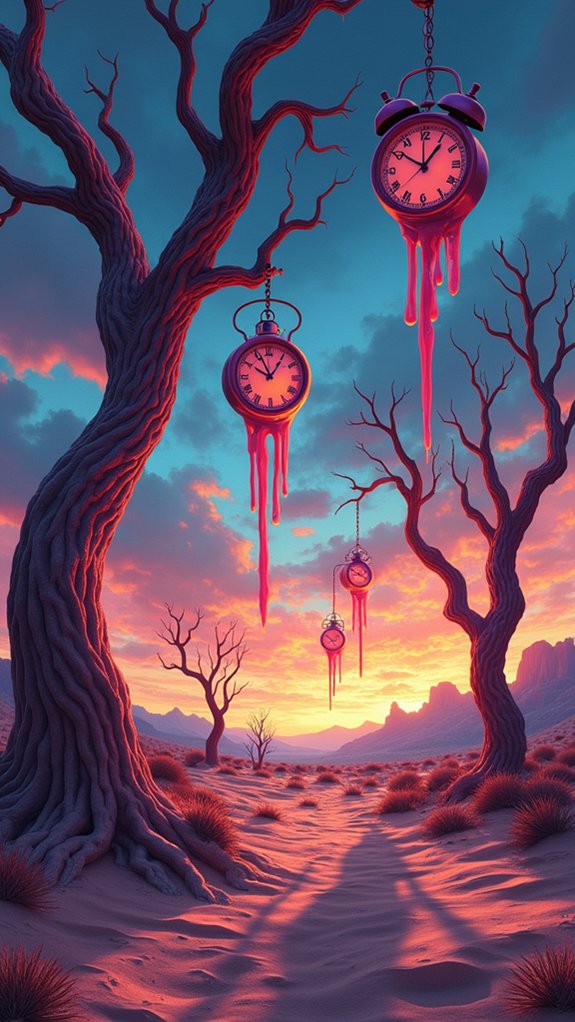
Artists exploring surreal art often play with frozen time concepts by depicting clocks in states of melting or warping, creating a dreamy feel that stops viewers in their tracks.
These bending perception techniques invite us to question what’s real and what’s just in our imagination, much like when we’re caught between sleep and wakefulness.
Symbolic clock imagery, made famous by Salvador Dalí, remains one of the most powerful ways to show how time isn’t always as rigid as we think, sometimes flowing like honey or standing completely still in our memories.
Frozen Time Concepts
When time starts to melt like ice cream on a hot summer day, the rules of reality bend in fascinating ways.
Frozen time concepts appear throughout surreal art, capturing moments that seem to stretch forever like taffy. Artists freeze a single breath, a falling tear, or a flying bird, making us wonder: is time even real?
Famous surrealists like René Magritte and Max Ernst created mind-bending scenes where clocks stop ticking and the world stands still.
These frozen moments tell stories about our memories and how quickly life zooms by.
Think about a photograph – it’s already a kind of frozen time!
Bending Perception Techniques
How does reality twist and bend in the mind of a surrealist? Through bending perception techniques, artists create dreamlike scenes where familiar objects transform into something extraordinary. Salvador Dalí’s melting clocks perfectly demonstrate this fluidity of time, warping our understanding of reality’s rigid structure.
Digital art has expanded these possibilities, allowing creators to layer and manipulate images in ways traditional mediums cannot.
- Stretching everyday objects until they become almost unrecognizable, yet still familiar
- Combining vibrant, impossible color schemes that wouldn’t exist in nature
- Playing with exaggerated perspectives that defy physics and spatial logic
- Mixing photography with digital painting to create hybrid realities
Surrealism invites us to question what we see, challenging our minds to explore beyond the ordinary.
These techniques don’t just create art—they open doorways to new ways of seeing our world.
Symbolic Clock Imagery
Few artistic symbols capture the essence of surrealism quite like the melting clock, dripping over edges and folding into impossible shapes.
Popularized by Salvador Dalí‘s famous painting “The Persistence of Memory,” these warped timepieces represent how time feels different depending on what we’re doing or feeling.
Artists on their artistic journey often use these bendy clocks to show how dreams mess with reality.
When you see a clock melting in a painting, it’s like the artist is saying, “Hey, time isn’t as solid as you think!”
These distorted timepieces can make us think about our memories, how quickly life passes, or even how weird time feels when we’re bored or having fun.
The next time you spot a melting clock, ask yourself: Is the artist inviting you into a world where the rules of reality don’t apply?
Human-Nature Hybrid Compositions
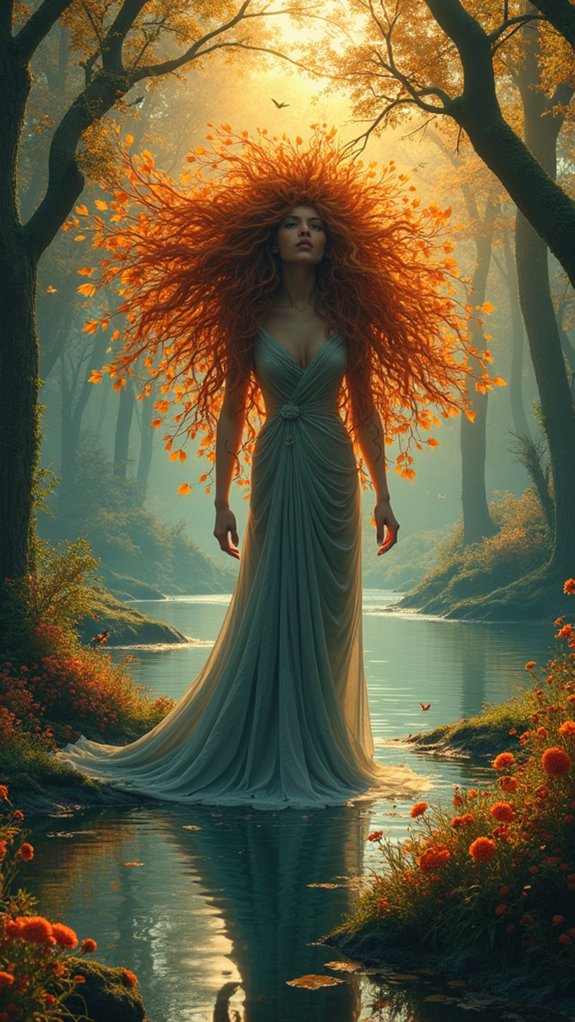
Human-Nature Hybrid Compositions in surreal art blend the boundaries between people and the natural world with mind-bending results.
These dreamy creations speak to every art lover’s fascination with transformation, showing humans with tree-like limbs or flower-petal skin in ways that feel both strange and familiar.
- Figures with leafy hair or bark-textured skin that symbolize our connection to Earth
- Dreamlike settings where human bodies sprout roots or branches in impossible ways
- Digital manipulations that combine actual photographs with natural scenery
- Vibrant color palettes that heighten the emotional impact of these magical beings
These hybrids invite us to think about how we interact with nature, challenging our ideas about what’s real and what’s possible in a seriously cool, thought-provoking way.
Miniature Worlds Within Ordinary Objects
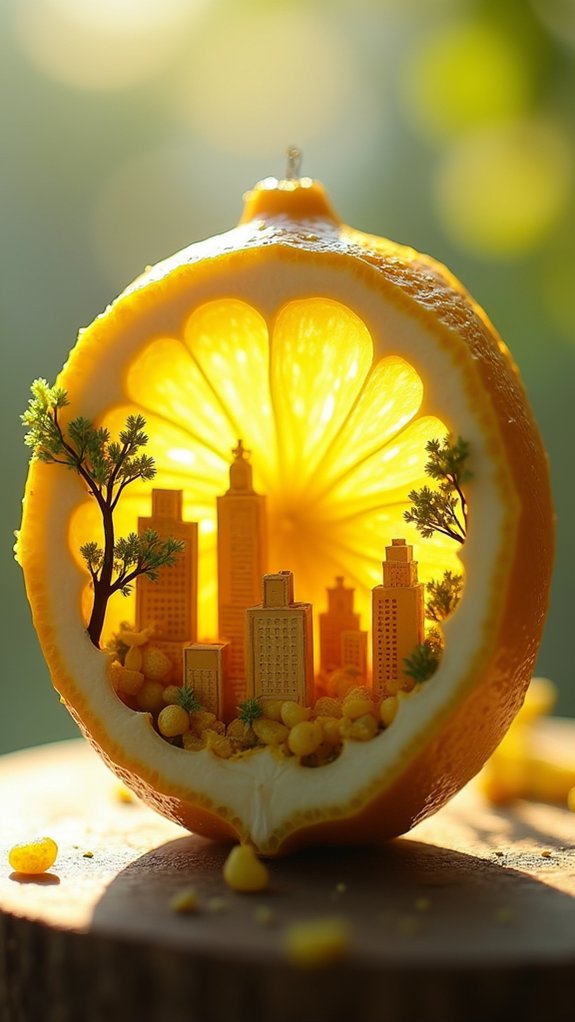
Imagination explodes into reality when ordinary objects transform into portals to tiny, spectacular universes. Artists like Joel Rea and Vladimir Kush have mastered this surreal technique, turning everyday items like teacups and shoes into gateways to fantastical scenes.
These miniature worlds draw viewers in with vibrant colors and intricate details that make the ordinary absolutely extraordinary!
The coolest part? These tiny universes challenge how we see reality. By using mixed media and dreamlike elements, artists create mind-bending environments that seem impossible yet strangely familiar.
Next time you look at a simple object, imagine what magical domain might be hiding inside it! These artistic transformations remind us that even the most mundane things in our daily lives can contain entire worlds of possibility and adventure.
Cosmic and Celestial Elements in Urban Settings
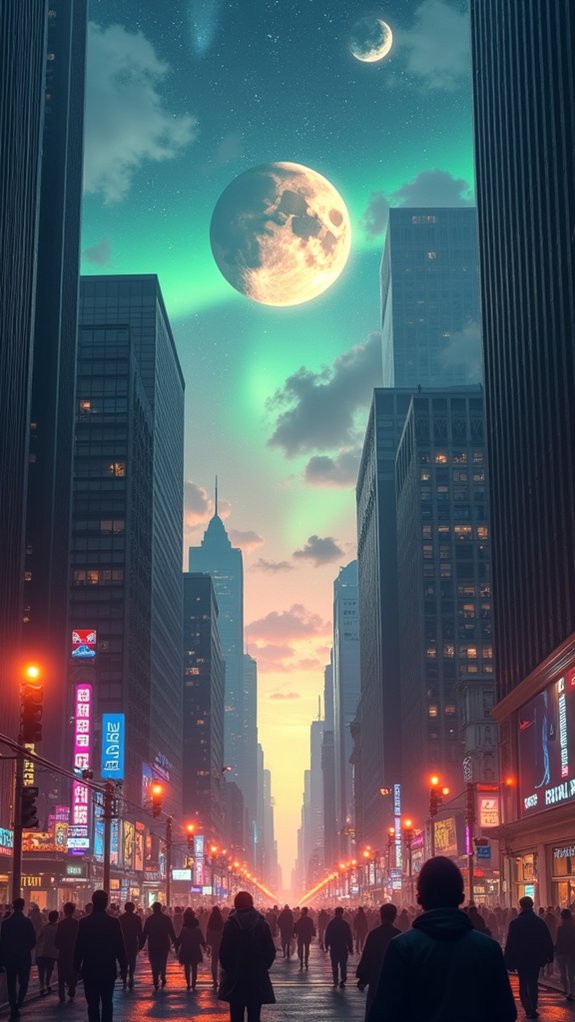
Countless urban environments transform into magical cosmic playgrounds when artists introduce celestial elements into familiar city settings. The stark contrast between concrete buildings and swirling galaxies creates a sense of wonder that makes viewers stop and stare.
Through digital manipulation, artists layer cosmic elements like shooting stars, planets, and nebulae over cityscapes, blurring the line between reality and fantasy.
- Skyscrapers reaching into star-filled skies, with the Milky Way replacing ordinary clouds
- Busy street intersections illuminated by the glow of distant planets instead of traffic lights
- Park benches positioned under aurora borealis, turning everyday rest spots into cosmic viewing areas
- Subway entrances that appear to lead into wormholes or spiral galaxies
These surreal combinations challenge our perception of urban spaces, making us reimagine the ordinary world around us.
Dreamlike Reflections in Impossible Waters
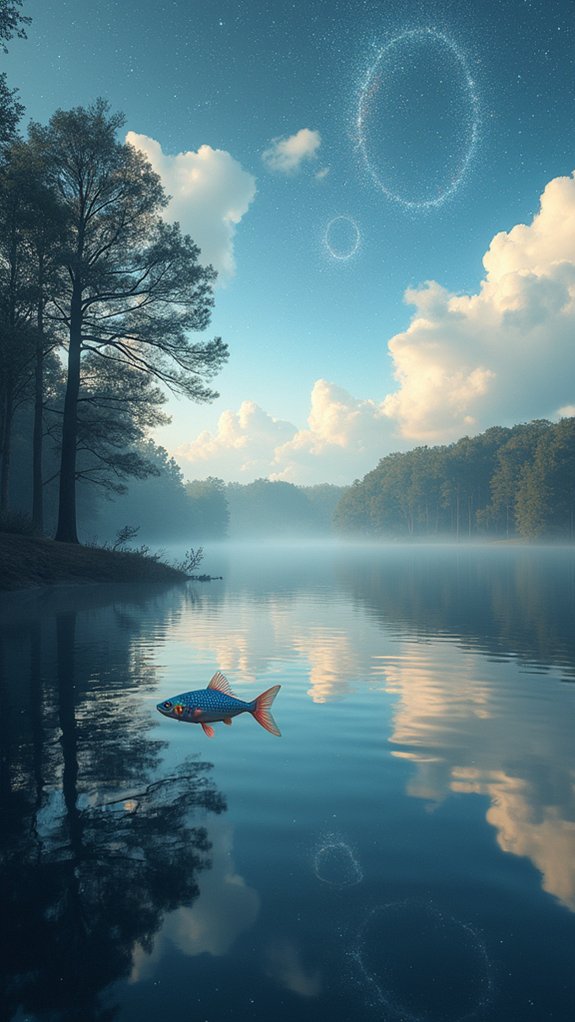
Water becomes a portal to other dimensions when artists create dreamlike reflections that defy physics and logic. In these surreal artworks, impossible waters mirror fantastical environments where floating objects, weird creatures, and warped buildings might appear upside-down in shimmering pools.
Artists splash vibrant colors across these watery canvases, using purples, teals, and golds that wouldn’t exist in natural reflections. The magic happens in the blurry line between what’s real and what’s imagined!
Digital tools help create these mind-bending scenes, though some artists mix traditional painting with collage for extra weirdness.
What makes these dreamlike reflections so cool is how they make us feel something deep and personal. Each viewer sees something different in the mysterious waters – like peeking into someone else’s dreams through a rippling, magical mirror.
Gravity-Defying Architectural Manipulations
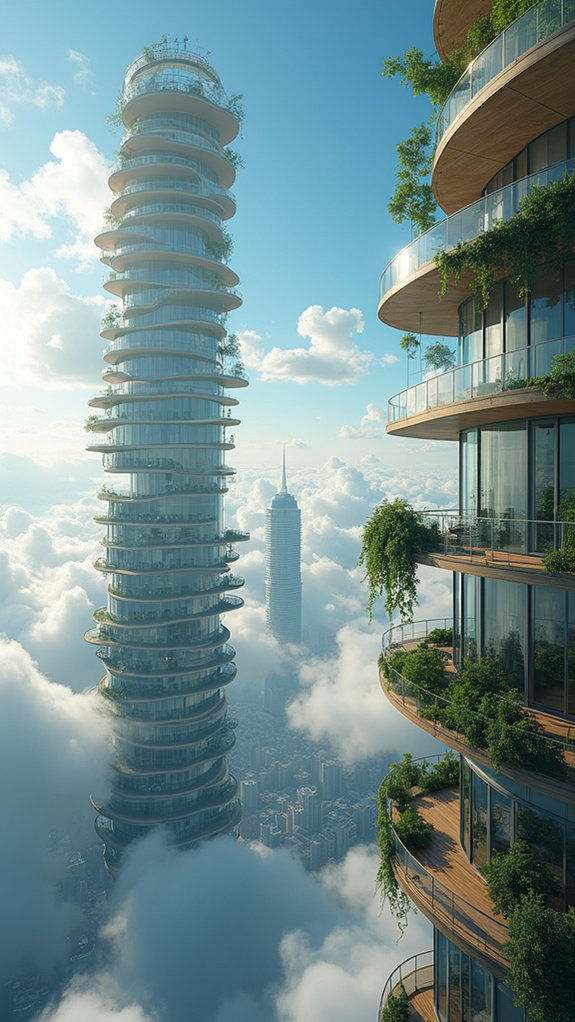
Gravity-defying architecture in surreal art transforms ordinary buildings into mind-bending spectacles that float, bend, and twist in ways that seem magically impossible.
Artists create floating urban wonderlands where entire city blocks hover in mid-air, connected by staircases that lead nowhere, or buildings that morph into spiraling shapes that defy structural logic.
These architectural manipulations play with our understanding of physics, inviting viewers to step into a world where skyscrapers might melt like ice cream, houses might balance on impossibly thin pillars, or entire neighborhoods might be turned upside-down and suspended from clouds.
Impossible Building Transformations
Architecture breaks free from reality’s chains in the sphere of surreal art, where buildings refuse to follow the rules of physics.
In this magical environment where the ordinary transforms into extraordinary, impossible building transformations blur the lines between what’s real and what’s imagined.
Artists like Olivier Lamboray create a world where reality bends, inviting viewers to see the world differently through structures that transcend the boundaries of what’s possible.
- Floating castles that hover among clouds, defying gravity with dreamlike grace
- Melting skyscrapers that drip like ice cream on a hot day, yet somehow remain standing
- Buildings that twist into impossible knots, as if made of rubber instead of concrete
- Structures that grow organically, sprouting branches and leaves like living trees
Floating Urban Wonderlands
In the realm of surreal art, entire cities break free from Earth’s pull, creating floating urban wonderlands that dance among the clouds. These gravity-defying architectural manipulations challenge our sense of reality, with buildings that hover impossibly against distorted celestial skies.
Artists often enhance these dreamlike scenes with oversized flowers and whimsical creatures that roam between suspended structures. Rich textures and vibrant colors bring these fantastical cityscapes to life, making them perfect conversation starters as wall decor.
The absurd blending of fantasy elements with recognizable urban spaces invites viewers to escape conventional thinking, if only for a moment. These floating environments aren’t just visually stunning—they’re portals to places where physics takes a vacation and imagination rules, offering a brief but magical retreat from everyday life.
Surreal Animal Transformations and Metamorphosis

Many surreal artists explore the fascinating realm of animal metamorphosis, where creatures shift between forms in ways that defy reality.
These metaphorical beasts serve as powerful symbols, allowing artists like Dalí and Rea to plunge into psychological themes and societal commentary through dreamlike imagery. The transformation of familiar creatures into something extraordinary challenges our perception, making us question the boundaries between reality and imagination.
- A deer sprouting mechanical gears instead of antlers, representing the clash between nature and technology
- Fish with human faces swimming through clouds, exploring identity fluidity
- Birds transforming into musical instruments mid-flight, symbolizing freedom and creative expression
- Wolves melting into watercolor vistas, suggesting environmental fragility
The vibrant colors and impossible forms in these works invite viewers into a world where anything is possible!
Light and Shadow Illusions in Impossible Spaces
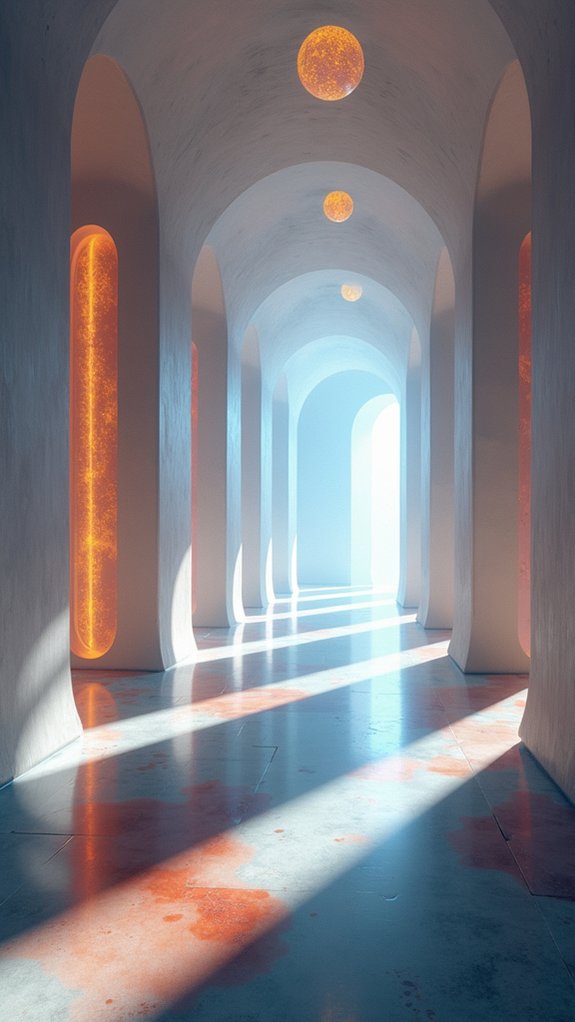
The mesmerizing dance between light and shadow creates some of the most enchanting illusions in surreal art. Artists manipulate these elements to bend reality, making viewers question what’s actually possible!
Shadow Play techniques can transform ordinary spaces into mind-bending environments where stairs lead to nowhere and doorways open to impossible rooms.
By using contrasting light sources, artists craft dreamlike scenes where objects appear to float or stretch beyond normal physics. The dramatic technique of chiaroscuro—where bright light meets deep darkness—adds emotional punch to these weird worlds.
Some artists even incorporate reflections and refractions to multiply the confusion, like mirrors facing mirrors in a funhouse!
When familiar light patterns get twisted, our brains struggle to make sense of what we’re seeing, and that’s exactly what makes these surreal illusions so enthralling!
Time-Bending Photography and Mixed Media
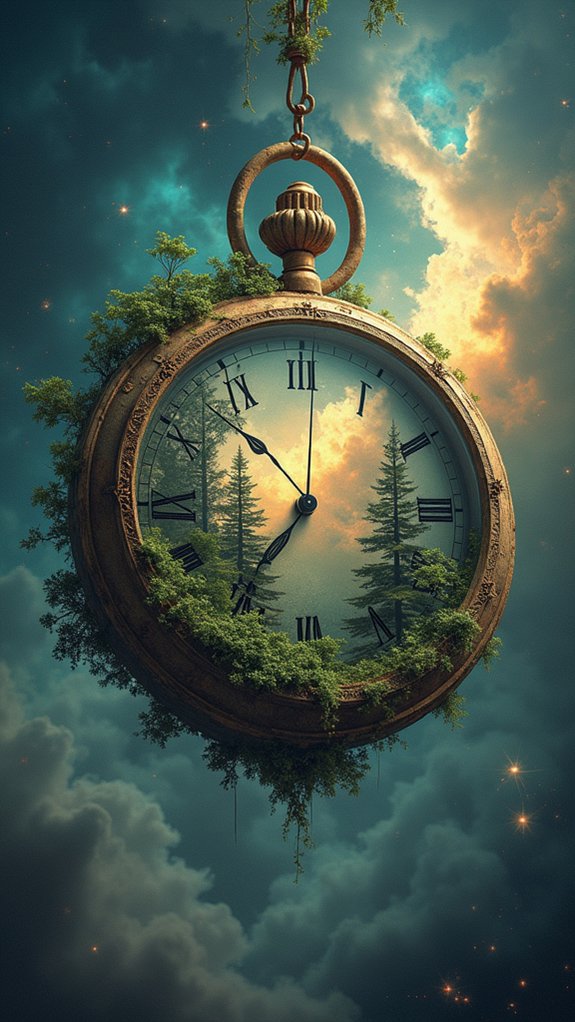
Time stands still, stretches, and warps in the fascinating world of time-bending photography and mixed media!
Artists create surreal narratives by combining still images with movement, playing with our perception of reality. These works feature Temporal Layers that tell stories across different moments, inviting viewers to question what’s real and what’s imagined.
Time is clay in the artist’s hands, molding perception through layered moments of reality and fantasy.
- Long exposure techniques that capture light trails, turning ordinary night scenes into magical light paintings
- Double exposures overlapping two time periods in a single frame, like showing both summer and winter in one incredible image
- Collage methods mixing vintage photographs with modern elements, creating mind-bending time paradoxes
- Digital manipulation that bends physical laws, showing impossible scenarios like water flowing upward or clouds forming shapes
These dreamlike creations challenge us to see time not as a straight line but as a playground for imagination!
Cloud Sculptures and Sky Manipulations
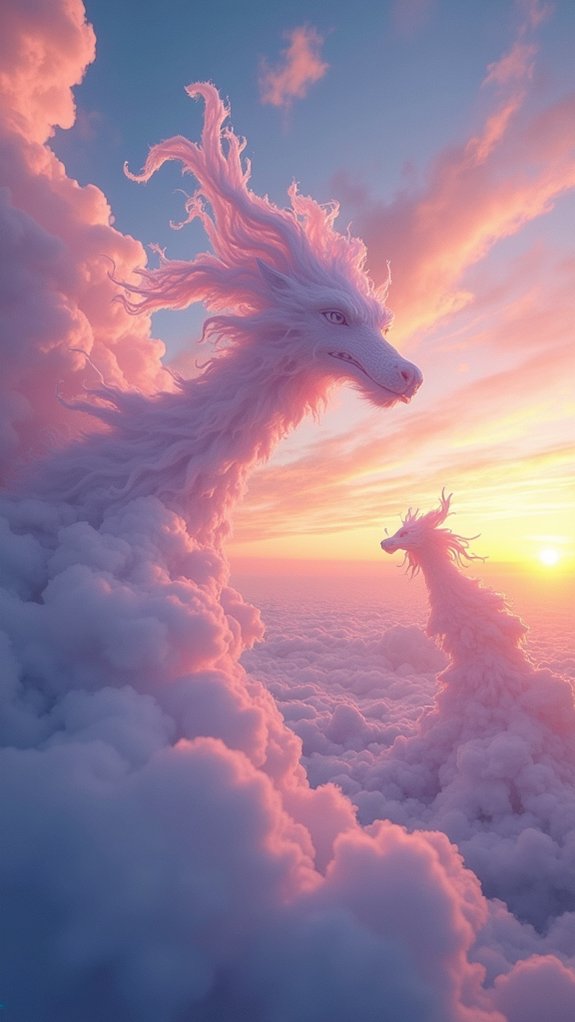
Imagine floating islands suspended in mid-air, majestic animal shapes drifting across the horizon, and celestial cities hanging upside-down in the atmosphere! Cloud sculptures transform ordinary skies into magical dreamscapes that blur the line between reality and fantasy. Artists digitally manipulate cloud photographs using layering techniques and color adjustments to create these Dreamy Horizons.
| Cloud Creation | Technique Used | Emotional Effect |
|---|---|---|
| Dragon Castle | Shadow Blending | Wonder |
| Floating Islands | Light Contrast | Adventure |
| Giant Ocean Waves | Color Inversion | Peaceful |
| Upside-down Cities | Perspective Shift | Confusion |
| Animal Guardians | Texture Layering | Protection |
Frequently Asked Questions
What Is an Art Movement That Combines Reality and Imagination With Unrealistic Subject Matters?
Surrealism represents a dreamscape fusion of reality and imagination, presenting unrealistic subject matters through juxtaposed elements that challenge conventional perception and explore the unconscious mind’s bizarre imagery.
What Are the 3 Major Aspects of Surrealism?
Surrealism’s three major aspects include unconscious dream exploration through irrational imagery, unexpected juxtapositions of ordinary objects creating bizarre scenes, and symbolic metaphors that transcend logical constraints of reality.
What Are 5 Themes of Surrealism?
Surrealism’s five prominent themes include dreams versus reality, unexpected juxtaposition of objects, symbolic representation, emphasis on the absurd, and transformation—all enriching the movement’s Dreamscapes Exploration through subconscious manifestations and psychological revelations.
What Are the 7 Characteristics of Surrealist Art?
Surrealist art encompasses seven key characteristics: automatism, dream exploration, irrational juxtapositions, metamorphosis, symbolic imagery, uncanny perspectives, and psychological depth revealed through unconscious expression and distorted reality.
Conclusion
Surreal art opens doors to worlds where imagination rules and reality bends. By trying these twelve incredible techniques, young artists can transform ordinary scenes into mind-blowing creations that make viewers look twice. Whether melting clocks or crafting tiny worlds inside teacups, the only limit is your creativity. So grab your supplies, break the rules of what’s “normal,” and watch as your wildest dreams take shape on canvas!

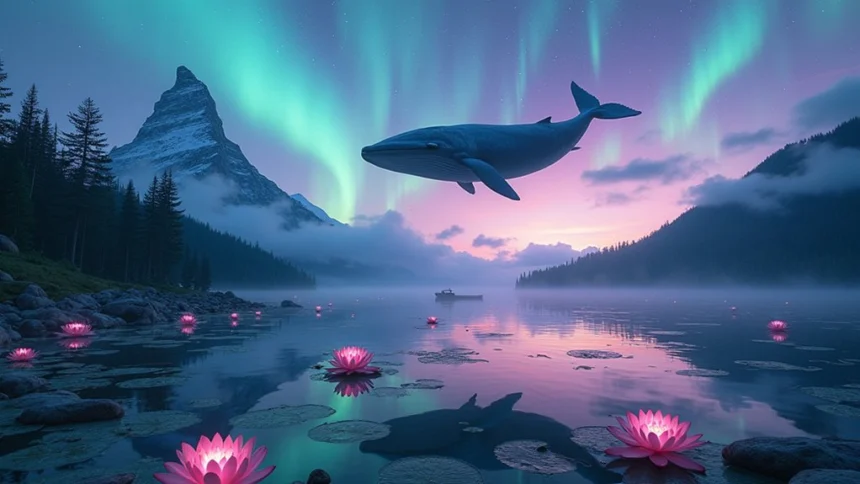
Leave a Reply